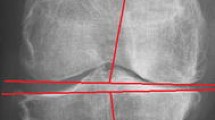Abstract
Background
In the Norwegian prospective study on Legg-Calvé-Perthes disease (LCPD), we found varus femoral osteotomy gave better femoral head sphericity at a mean of 5 years postoperative than physiotherapy in children older than 6.0 years at diagnosis with femoral head necrosis of more than 50%. That study did not include separate analyses for hips with 100% necrosis and those with a percentage of necrosis between 50% and 100%.
Questions/purposes
We asked whether (1) femoral osteotomy improves femoral head sphericity at followup in all patients with more than 50% femoral head necrosis or in selected groups only and (2) there is a critical age between 6.0 and 10.0 years over which femoral osteotomy does not improve the prognosis.
Methods
We treated 70 patients with unilateral LCPD, age at diagnosis of more than 6.0 years, and femoral head necrosis of more than 50% with varus femoral osteotomy between 1996 and 2000. We classified necrosis using the Catterall classification. We established a control group of 51 similar children who received physiotherapy. At the 5-year followup visit, the hips were graded according to femoral head shape: spherical, ovoid, or flat.
Results
At 5-year followup, there was no difference between the treatment groups in radiographic outcome in Catterall Group 3 hips. In Catterall Group 4 hips, femoral head sphericity was better in the osteotomy group, with flat femoral heads in 14% compared to 75% after physiotherapy. The same trend toward better head sphericity occurred when the lateral pillar classification was used.
Conclusions
In children aged 6.0 to 10.0 years, in whom the whole femoral head is affected, femoral head sphericity 5 years after femoral osteotomy was better than that after physiotherapy.
Level of Evidence
Level II, therapeutic study. See Guidelines for Authors for a complete description of levels of evidence.


Similar content being viewed by others
References
Aksoy MC, Cankus MC, Alanay A, Yazici M, Caglar O, Alpaslan AM. Radiological outcome of proximal femoral varus osteotomy for the treatment of lateral pillar group-C Legg-Calvé-Perthes disease. J Pediatr Orthop B. 2005;14:88–91.
Catterall A. The natural history of Perthes’ disease. J Bone Joint Surg Br. 1971;53:37–53.
Coates CJ, Paterson JM, Woods KR, Catterall A, Fixsen JA. Femoral osteotomy in Perthes’ disease. J Bone Joint Surg Br. 1990;72:581–585.
Dickens DR, Menelaus MB. The assessment of prognosis in Perthes’ disease. J Bone Joint Surg Br. 1978;60:189–194.
Friedlander JK, Weiner DS. Radiographic results of proximal femoral varus osteotomy in Legg-Calvé-Perthes disease. J Pediatr Orthop. 2000;20:566–571.
Green NE, Beauchamp RD, Griffin PP. Epiphyseal extrusion as a prognostic index in Legg-Calvé-Perthes disease. J Bone Joint Surg Am. 1981;63:900–905.
Herring JA, Kim HT, Browne R. Legg-Calvé-Perthes disease. Part II. Prospective multicenter study of the effect of treatment on outcome. J Bone Joint Surg Am. 2004;86:2121–2134.
Herring JA, Neustadt JB, Williams JJ, Early JS, Browne RH. The lateral pillar classification of Legg-Calvé-Perthes disease. J Pediatr Orthop. 1992;12:143–150.
Heyman CH, Herndon CH. Legg-Perthes disease. J Bone Joint Surg Am. 1950;32:767–778.
Joseph B, Varghese G, Mulpuri K, Rao N, Nair NS. Natural evolution of Perthes disease: a study of 610 children under 12 years of age at disease onset. J Pediatr Orthop. 2003;23:590–600.
Kelly FB, Canale ST, Jones RR. Legg-Calvé-Perthes disease: long-term evaluation of non-containment treatment. J Bone Joint Surg Am. 1980;62:400–407.
Neyt JG, Weinstein SL, Spratt KF, Dolan L, Morcuende J, Dietz FR, Guyton G, Hart R, Kraut MS, Lervick G, Pardubsky P, Saterbak A. Stulberg classification system for evaluation of Legg-Calvé-Perthes disease: intra-rater and inter-rater reliability. J Bone Joint Surg Am. 1999;81:1209–1216.
Noonan KJ, Price CT, Kupiszewski SJ, Pyevich M. Results of femoral varus osteotomy in children older than 9 years of age with Perthes disease. J Pediatr Orthop. 2001;21:198–204.
Stulberg SD, Cooperman DR, Wallensteen R. The natural history of Legg-Calvé-Perthes disease. J Bone Joint Surg Am. 1981;63:1095–1108.
Terjesen T, Wiig O, Svenningsen S. The natural history of Perthes disease: risk factors in 212 patients followed for 5 years. Acta Orthop. 2010;81:708–714.
Wiig O, Terjesen T, Svenningsen S. Inter-observer reliability of the Stulberg classification in the assessment of Perthes disease. J Child Orthop. 2007;1:101–105.
Wiig O, Terjesen T, Svenningsen S. Prognostic factors and outcome of treatment in Perthes’ disease: a prospective study of 368 patients with five-year follow-up. J Bone Joint Surg Br. 2008;90:1364–1371.
Acknowledgments
The authors thank the statistician Are Hugo Pripp for help and advice with the statistical analysis.
Author information
Authors and Affiliations
Corresponding author
Additional information
Each author certifies that he or she has no commercial associations (eg, consultancies, stock ownership, equity interest, patent/licensing arrangements, etc) that might pose a conflict of interest in connection with the submitted article.
All ICMJE Conflict of Interest Forms for authors and Clinical Orthopaedics and Related Research editors and board members are on file with the publication and can be viewed on request.
Clinical Orthopaedics and Related Research neither advocates nor endorses the use of any treatment, drug, or device. Readers are encouraged to always seek additional information, including FDA approval status, of any drug or device before clinical use.
Each author certifies that all investigations were conducted in conformity with ethical principles of research and that informed consent for participation in the study was obtained.
This work was performed at Oslo University Hospital, Oslo, Norway.
About this article
Cite this article
Terjesen, T., Wiig, O. & Svenningsen, S. Varus Femoral Osteotomy Improves Sphericity of the Femoral Head in Older Children With Severe Form of Legg-Calvé-Perthes Disease. Clin Orthop Relat Res 470, 2394–2401 (2012). https://doi.org/10.1007/s11999-011-2181-7
Published:
Issue Date:
DOI: https://doi.org/10.1007/s11999-011-2181-7




